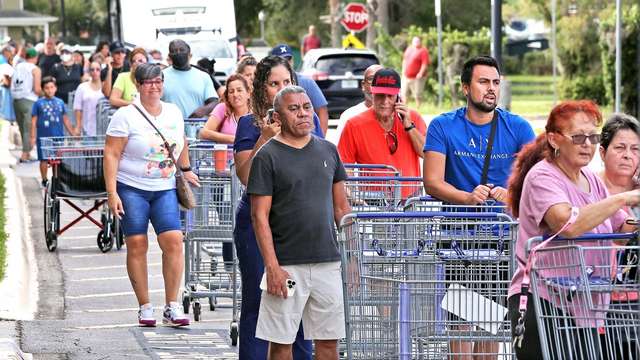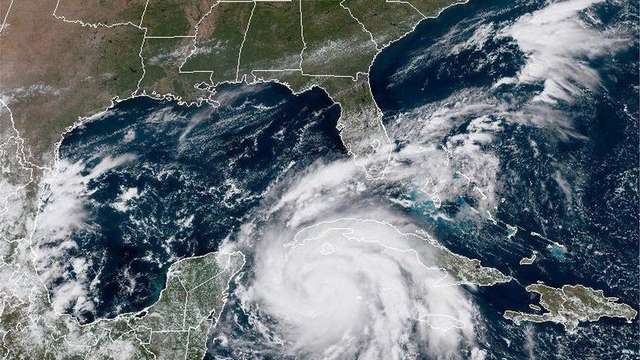

For the past few days, the people of Florida have paused all their businesses, schools, churches, and leisure because an uninvited guest is coming closer and closer, and there is nothing the residents can do to stop it. That visitor is Hurricane Ian.
Hurricane Ian has reached winds up to 100 mph as of Monday night, making it a Category 2 storm on the Saffir-Simpson wind scale. Experts are worried that it could become a major hurricane, reaching category 3 or more before hitting the United States on Wednesday. It is expected to reach Cuba on Tuesday morning and Florida on Wednesday. Environmental analysts are worried that it could cause unprecedented damages never experienced before now.
The national weather service said Hurricane Ian would bring a life-threatening storm along much of the Florida west coast when it arrives on Wednesday, but the state could begin feeling its presence as early as Tuesday.
“[Ian] is expected to be a major hurricane in the eastern Gulf of Mexico during the middle of this week. Regardless of Ian’s exact track, there is a risk of a life-threatening storm surge, hurricane-force winds, & heavy rainfall along the west coast/Panhandle of Florida by mid-week,” the national weather service said on Monday.
The calls for evacuation
Despite the fears that are expected to come with the hurricane, it appears many residents in Floria do not see the seriousness of the situation. For this reason, several counties in Florida have issued mandatory evacuation orders.
“Effective 6 p.m. today [Monday], all residents in Evacuation Zone A (including all mobile home residents) will be under mandatory evacuation orders. Mandatory orders for evacuation zones B and C will be effective tomorrow morning at 7 a.m,” Pinellas county said on Twitter.
County Sheriff Bob Gualtieri said the evacuation order means residents that fail to comply would not get further assistance from the government, even if they call for help.
“When we issued that mandatory evacuation, what that means is if you don’t and you call for help, we’re not coming because we’re not going to put our people in harm’s way and put them in peril because you didn’t listen to what we told you to do,” Pinellas County Sheriff Bob Gualtieri said.
Tampa Bay also announced a compulsory evacuation on Monday for residents in zone A but said a voluntary evacuation is recommended for residents in zones B.
“Mother nature always wins. And this storm is going to be a very impactful storm whether it is offshore or it comes closer to Tampa Bay. And so this is nothing to mess around with. If you can leave, just leave now. And we will take care of your personal property,” Tampa mayor Jane Castor said on Monday.
Tampa-area University also announced the complete closure of classes because it was difficult to predict the outcome of the natural disaster.
“The path of the storm remains highly unpredictable and could change in the coming days. That said, the safety of our students, faculty, and staff is our highest priority as we track the storm,” the University statement reads.
The Tampa Bay airport said it would remain operational until Tuesday evening because of its role in the evacuation process.
Reluctance to heed evacuation warnings
The government could only do its part by giving evacuation orders and doing its best to execute them. What they cannot do is compel adults to heed the calls for evacuation.
As of Monday, some residents are still reluctant to leave the areas where Ian would hit the most.
Khadijah Jones is one of the residents of Tampa Bay that believes the waters and storm would not cause severe damage in the region.
“We will be staying home. Not in an evacuation zone. Just doing the basics… securing loose materials in the yard, sandbags in low areas, and getting items to prep for no power,” Jones told CNN.
She said she had experienced other hurricanes, including Hurricane Isabel in Virginia, and Hurricane Irma in Florida. Jones said she is not sure if her home would be affected since it was her first hurricane in the home she lives in.
Kevin Guthrie, director of the Florida Division of Emergency Management, is worried for people like Ms. Jones because they might call for last-minute help that might never come.
“I’m worried about people being complacent and getting tired of trying to get on the road or sitting in traffic and they turn around and go back home or they don’t get on the road at all,” he told CNN.
Pinellas County Sheriff Bob Gualtieri said: “Nobody’s coming and knocking on your doors, nobody’s coming and taking anybody out when it says mandatory. What that means is you need to do it and if you don’t do it, you’re on your own. Please don’t put yourselves in that situation.”
Preparing for the worst, hoping for the best
For the people of Florida, it has become inevitable that anything could divert the movement of Hurricane Ian. They had no other option but to prepare for what could become the worse day(s) of their lives.
“Right now, of course, we are like many other cities, we’re preparing for the worst; hoping for the best,” Cape Coral mayor John Gunter told CNN.
“It’s better to be prepared than sorry later. I was in Puerto Rico visiting my parents a couple of days before Fiona hit. I was helping them out, and now I’m here helping myself and everybody else,” Lugo, a resident of Florida, said.
For a certainty, Hurricane Ian would not spare Florida this time. It is already attacking Cuba, and reports show that almost 20,000 people have been evacuated as of Tuesday morning. Another 50,000 awaits evacuation as nature continues to show its strength. As for the people of Florida, they are hoping to see a hurricane that is not as damaging as described because if it is, it would be the worst in the State’s history.












0 Comments